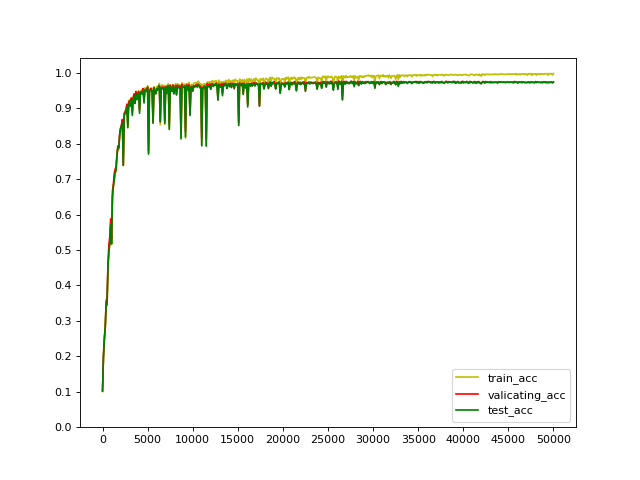import tensorflow as tf
from dataset import *
import time
#时间标记起始点
time.clock()
#导入数据
x_train, y_train, x_validating, y_validating, x_test, y_test = data_set()
#定义参数
layer_dimensions = [784, 30, 50, 25, 33, 25, 15, 20, 10]
regularization_rate = 0.001
w_cache, b_cache = initialization(layer_dimensions)
#数据输入接口
x = tf.placeholder(tf.float32, shape=(None,784), name='x_input')
y_ = tf.placeholder(tf.float32, shape=(None,10), name='y_input')
#前向传播
y, regularizer_cache = propagation_forward(x, w_cache, b_cache, regularization_rate)
#普通损失函数,均方失真
cross_entropy_mean = tf.nn.sparse_softmax_cross_entropy_with_logits( logits=y, labels=tf.argmax(y_, 1)) #logits为未归一化的量
loss = cross_entropy_mean + tf.accumulate_n(regularizer_cache)
#优化方法
global_step = tf.Variable(0)
learning_rate = tf.train.exponential_decay(0.01, global_step, 100, 0.99, staircase=True)
train_step = tf.train.AdamOptimizer(learning_rate).minimize(loss, global_step=global_step)
#正确度计算
correct_prediction = tf.equal(tf.arg_max(y, 1), tf.arg_max(y_, 1))
accuracy = tf.reduce_mean(tf.cast(correct_prediction, tf.float32))
#创建会话
with tf.Session() as sess:
#初始化变量
init_op = tf.global_variables_initializer()
sess.run(init_op)
STEPS = 50000
batch_size = 256
x_axis = [i for i in range(STEPS+1) if (i % 100 == 0)]
train_line = []
validating_line = []
test_line = []
for i in range(STEPS+1):
xs, ys = batch(x_train, y_train, batch_size, i)
sess.run(train_step, feed_dict={x: xs, y_: ys})
#计算正确率
if i % 100 == 0:
train_acc = sess.run(accuracy, feed_dict={x: x_train, y_: y_train})
validating_acc = sess.run(accuracy, feed_dict={x: x_validating, y_: y_validating})
test_acc = sess.run(accuracy, feed_dict={x: x_test, y_: y_test})
train_line.append(train_acc)
validating_line.append(validating_acc)
test_line.append(test_acc)
if i % 1000 == 0:
print("after %d train steps, train accuracy on model is:%s" % (i, train_acc))
#print("after %d train steps, validating accuracy on model is:%s" % (i, validating_acc))
print("after %d train steps, test accuracy on model is:%s" % (i, test_acc))
#输出运行时间
print("total_time is:%s" % time.clock())
#性能曲线图
draw(x_axis, train_line, validating_line, test_line)
辅助函数:
from tensorflow.examples.tutorials.mnist import input_data
import tensorflow as tf
import matplotlib.pyplot as plt
import numpy as np
def data_set():
mnist = input_data.read_data_sets("D:/DL_dataset/TensorFlow/", one_hot=True)
x_train = mnist.train.images #(55000,784) 图片为28*28=784像素,以下也是
y_train = mnist.train.labels #(55000,10)
x_validating = mnist.validation.images #(5000,784)
y_validating = mnist.validation.labels #(5000,10)
x_test = mnist.test.images #(10000,784)
y_test = mnist.test.labels #(10000,10)
return x_train, y_train, x_validating, y_validating, x_test, y_test
def initialization(layer_dimensions):
w_cache = []
b_cache = []
for i in range(1, len(layer_dimensions)):
w = tf.Variable(tf.random_normal((layer_dimensions[i-1], layer_dimensions[i]), stddev=1, seed=1))
b = tf.Variable(tf.constant(0., shape=[1, layer_dimensions[i]]))
w_cache.append(w)
b_cache.append(b)
return w_cache, b_cache
#前向传播与正则项计算
def propagation_forward(x, w_cache, b_cache, regularization_rate):
a = x
long = len(w_cache)
regularizer_cache = []
regularizer = tf.contrib.layers.l2_regularizer(regularization_rate)
if long> 1:
for i in range(long-1):
a = tf.nn.tanh(tf.matmul(a, w_cache[i]) + b_cache[i])
regularizer_cache.append(regularizer(w_cache[i]))
a = tf.matmul(a, w_cache[long-1]) + b_cache[long-1]
regularizer_cache.append(regularizer(w_cache[long-1]))
return a, regularizer_cache
#画性能曲线
def draw(total_iteration, train, validating, test):
plt.figure(figsize=(8, 6), dpi=80)
plt.subplot(1, 1, 1)
xmin, xmax = min(total_iteration), max(total_iteration)
ymin, ymax = min(train), max(train)
#dx = (xmax - xmin) * 0.2
#dy = (ymax - ymin) * 0.2
plt.plot(total_iteration, train, '-y', label='train_acc')
plt.plot(total_iteration, validating, '-r', label='valicating_acc')
plt.plot(total_iteration, test, '-g', label='test_acc')
plt.legend(loc='lower right')
# 设置轴记号
plt.xticks(np.linspace(0, xmax, 11, endpoint=True))
plt.yticks(np.linspace(0, 1.0, 11, endpoint=True))
plt.show()
#设置批量
def batch(x_train, y_train, batch_size, i):
#整除运算,返回批数量
batch_nums = x_train.shape[0] // batch_size
i = i % batch_size
#舍弃掉最后批整数倍以外的多余数据
start = batch_size * i
end = batch_size * (i + 1) - 1
xs = x_train[start:end]
ys = y_train[start:end]
return xs, ys
结果:训练集与测试集正确率分别为:99.83%, 97.39%
